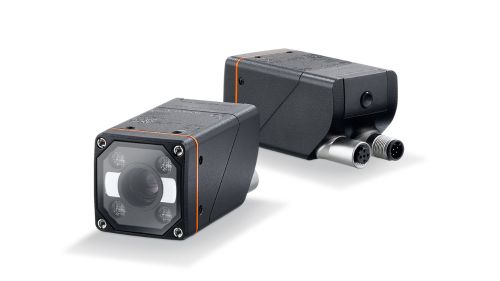Fraunhofer Research Institution – research into more efficient battery cell production
The Dualis 2D vision sensor from ifm keeps a close eye on electrode manufacture
Electromobility is still racing along the fast lane worldwide. Between 2020 and 2023 alone, the proportion of registered e-vehicles increased from below five per cent to an estimated 18 per cent – and the trend is clearly rising.
However: if the intended mobility transition is to be fully accomplished, one thing in particular is required: increased capacity in the production of powerful batteries – and very soon, too. As the link between science, research and industry, the Fraunhofer Research Institution for Battery Cell Production FFB intends to contribute to ensuring that the development of new, powerful cell formats is accelerated.
The target for Europe has been set: the EU aims to play a more important role in the battery cell production market in the future, and has set itself the target of considerably improving production efficiency by as early as 2030. This is to include reducing rejects to below five percent – an ambitious undertaking, as Fabian Kux, Research Associate (Quality Assurance) at the Fraunhofer FFB, clarifies: “Reject rates are still noticeably high along the entire battery production process chain worldwide.” Well-adjusted plants produce around 10 per cent scrap; this percentage may be even higher during the ramp-up phase. “Therefore, our aim is to accelerate the manufacture of innovative and, above all, efficient battery cells,” says Kux.
Quality assurance using 2D vision sensors
The FFB already ascribes an important role to automation technology. “An important element of our research is working out how sensor technology can help to enhance the quality of the products and the efficiency of the individual process steps.” Within the framework of a joint project with ifm, Kux and his team are testing the possibilities for using the Dualis 2D vision sensor, for example. The Dualis checks contours and surfaces and compares the actual state with the target specification. This enables reliable detection of the smallest differences in details, such as missing retaining clamps or malformed threads. In addition, surface dimensions can be analysed, such as – in this specific use case – those of the slurry, a paste of active materials, conductive additives, solvents and binding agents, that has been applied. The vision sensor reliably recognises a defective application and emits an error message. The process can then be readjusted to avoid further rejects and to maintain a high level of product quality in the manufacturing process. Integrating the vision sensor is extremely simple: the 2D vision sensor can be parameterised for most use cases by means of the teach function of the free ifm Vision Assistant software and its parameterising assistants and a few mouse clicks.
Three applications for the Dualis
“In consultation with automation specialist ifm, we identified three applications for which the Dualis can be used,” explains Kux. “The first application involves detecting defects in the freshly applied electrode slurry on the surface of the film substrate. You see, contamination or missed areas will have a negative effect on the safety and performance of the cell and must therefore be identified as scrap,” says Kux. “The dimensions of the coating are checked at the same time. In a continuous application process, the width of the film is measured; in an intermittent application process, the length is also measured.”


At the beginning of the production process, the Dualis vision sensor (O2D5) monitors the application of the slurry. Double-sided monitoring is also being tested at the Fraunhofer Research Institution.
Always precisely wound
If both sides of a film are being coated, a second Dualis is used to inspect the underside.
“In this case, we have to ensure that the slurry is applied to both sides in equal measure in order to guarantee the required quality.” In the third scenario, the Dualis inspects the edge of the film and coating. “Wet slurry is applied to the film and then goes through a drying process. The coated, dried electrode film is then wound up. Otherwise the irregular load can damage the film and coating.


Image 1: Gaps in the slurry coating result in rejection and it is imperative that they be identified. ifm’s Dualis vision sensor indicates this defect, thus helping to keep the reject rate to a minimum.
Image 2: The Dualis also reliably identifies irregularities or pockets in the applied slurry, assuring quality and high productivity.
From the digital twin to the battery passport
The vision sensor data can be used not only to reduce the reject rate at an early stage and ensure quality. From 2026 it will be mandatory for all newly produced batteries to have a battery passport. This will contain information not only about the supply chain and the new or recycled raw materials used, but also about the performance and health of the battery. “All the data that the sensors record along the entire production process can be transferred to the digital twin. This can then be used to easily create the battery passport.”
A good example of a successful partnership
The Fraunhofer FFB is still in the start-up phase. In the future, the Münster location will provide the capacity for high-volume, industrial-scale production. “This is intended to enable us to produce batteries at high throughput in order to jointly test new technologies with partners in industry in research projects in real conditions. The collaboration with ifm is thus a good example of how we can test, optimise and upscale the battery cell manufacturing technologies of the future with our partners.
Conclusion
In partnership with the Fraunhofer Research Institution for Battery Cell Production FFB, ifm can test its Dualis 2D vision sensor in real conditions. In the future, the resulting insights will help everyone: the Fraunhofer FFB, ifm, battery cell manufacturers and electromobility as a whole.



